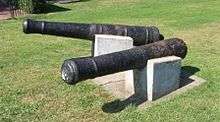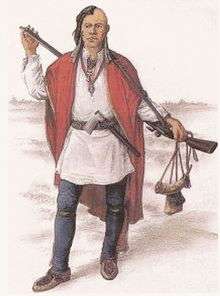Naval battle off Tatamagouche
| ||||||||||||||||||||||||||||||


The Action of 15 June 1745 was a naval encounter between three New England vessels and a French and native relief convoy en route to relieve the Siege of Louisbourg (1745) during King George's War. The French and native convoy of four French vessels and fifty native canoes carrying 1200 fighters was led by Paul Marin de la Malgue and the New England forces were led by Captain David Donahew. The New Englanders were successful. The Governor of Ile Royal Louis Du Pont Duchambon thought that the New Englanders would have ended their siege of Louisbourg had Marin arrived.[6] (There were 1800 French soldiers at Louisbourg versus 4200 New Englanders.) Instead, the day following the battle, Duchambon surrendered Louisbourg to New England.[7]
Background
At the outbreak of the war, in May 1744, Captain David Donahue of the Resolution took prisoner the chief of the Mi'kmaq people of Ile Royale Jacques Pandanuques with his family to Boston and killed him.[8] [9]
In May 1745, Paul Marin de la Malgue led 200 troops and hundreds of Mi'kmaq joined a siege against Annapolis Royal. The siege was ended after three weeks when Marin was recalled to assist with defending the French during the Siege of Louisbourg (1745).[10]
During the Siege at Annapolis, the Wabanaki Confederacy (Mi'kmaq and Maliseet) took prisoner William Pote and some of Gorham's Rangers. During his captivity, Pote wrote one of the most important captivity narratives from Acadia and Nova Scotia. While at Cobequid, Pote reported that an Acadian said that the French soldiers should have "left their [the English] carcasses behind and brought their skins."[11] He also wrote about the Naval battle off Tatamagouch.
Battle
Captain Donahew in the Resolution (12 guns, 50 crew) was travelling with Captain Daniel Fones in the Tartar (14 guns, 100 crew); and Captain Robert Becket in the Bonetta (six guns). The two latter ships left the Resolution to pursue smoke from what they believed to be a French and native encampment. Shortly after they left, four French vessels appeared, led by Marin. Upon seeing the native canoes, Captain Donahew hoisted a French flag on his own sloop so the natives would think it was a French privateer with a prize. The wind dropped off and the Resolution was becalmed and surrounded by the French vessels and canoes. At 10:00 am on 15 June 1745, Donahew raised the British flag on his ship and a fierce two-hour battle ensued. Donahew reported firing at the four vessels two hundred rounds from his four pounders; fifty-three rounds from his three pounders, and "my swivel and small Arms continually playing on them.”[12] The British reported there was a "considerable slaughter" of the French and natives.[13]
The four French vessels were about to board Donahew’s vessel when relief arrived, Captain Fones and Captain Becket returned. As a result, the French retreated to Gouzar. The two other French vessels went up near-by Dewar's River. The natives remained behind a seawall.
The convoy eventually retreated to Tatamagouch. They built defenses on land, anticipating an attack by the New Englanders. Another New England vessel appeared. A week after the initial attack, presumably because of the number of their losses, the Huron decided to abandon the convoy and return to Quebec.
Aftermath
| Military history of Mi’kmaq people | ||||||||||||||||||||||||||||||||||||||||||||||||||||||||||||||||
|---|---|---|---|---|---|---|---|---|---|---|---|---|---|---|---|---|---|---|---|---|---|---|---|---|---|---|---|---|---|---|---|---|---|---|---|---|---|---|---|---|---|---|---|---|---|---|---|---|---|---|---|---|---|---|---|---|---|---|---|---|---|---|---|---|
 Mi’kmaq Warrior | ||||||||||||||||||||||||||||||||||||||||||||||||||||||||||||||||
| Events | ||||||||||||||||||||||||||||||||||||||||||||||||||||||||||||||||
|
||||||||||||||||||||||||||||||||||||||||||||||||||||||||||||||||
| Other | ||||||||||||||||||||||||||||||||||||||||||||||||||||||||||||||||
|
| ||||||||||||||||||||||||||||||||||||||||||||||||||||||||||||||||
The battle was significant in the downfall of Louisbourg because Marin's relief envoy was thwarted.[14] Without the relief of the convoy, the following day Louisbourg fell.[15]
Weeks after the fall of Louisbourg, Donahew and Fones again engaged Marin, who was now nearing the Strait of Canso. Donahew and 11 of his men put ashore and were immediately surrounded by 300 Indians. The captain and five of his men were slain and the remaining six were taken prisoner. The Indians were said to have cut open Donahew's chest, sucked his blood, then eaten parts of him and his five companions. This tale significantly heightened the sense of gloom and frustration settling over the fortress. On July 19, the 12-gun provincial cruiser of Donavan’s the Resolution sailed slowly into the harbour with her colours flying at half-mast. The horrifying tale of the fate of her captain, David Donahew, and five crew members spread rapidly through the fortress.[16]
Legacy
In commemoration of this battle, the Historic Sites Monument Board, in August 1939, erected at Tatamagouche a monument in a spot overlooking the waters of the Harbour. (See Battle of Tatamagouche Monument.)
Captain Fones brought the "Tartar" (14 canons/ guns) back safe to her home port in Rhode Island. Two cannons from the Tartar are on the lawn of the Newport Historical Society (See Tartar's Guns), which were formerly mounted close to the Oliver Perry Monument at Washington Square, Newport, Rhode Island[17]
See also
References
Endnotes
- ↑ https://archive.org/stream/journalofcaptain00pote#page/174/mode/2up
- ↑ (Estimates 200- 1000 (Pote says 200, p. 16; Donahew reports 1000 p. 17; Howard Millar Chapin. New England Vessels in the Expedition Against Louisbourg, 1745. Providence, R. I. )
- ↑ (Howard Millar Chapin. New England Vessels in the Expedition Against Louisbourg, 1745. Providence, R. I. )
- ↑ (pote’s journal)
- ↑ Howard Millar Chapin. New England Vessels in the Expedition Against Louisbourg, 1745. Providence, R. I.
- ↑ (Beamish Murdoch. A History of Nova Scotia Vol. 2, p. 74; Patterson, p 17; "Pote’s Journal" ibid p. xxvii)
- ↑ Contemporary British colonial accounts record the siege as occurring 30 April – 16 June in the Old Style.
- ↑ Canadian Biography. Donahue used the same strategy of posing as a French ship to entrap Chief Pandanuques as he does in the Naval battle off Tatamagouche.
- ↑ Pierre Malliard.MEMORIAL OF THE Motives of the Savages, called Mickmakis and Maricheets, for continuing the War with England since the last Peace.
- ↑ Griffiths, E. From Migrant to Acadian. McGill-Queen's University Press. 2005. pp. 351
- ↑ (William Pote's Journal, 1745, p. 34)
- ↑ (Howard Millar Chapin. New England Vessels in the Expedition Against Louisbourg, 1745. Providence, R. I. )
- ↑ Ralph M. Eastman. "Captain Noah Stoddard" in Some Famous Privateers of New England. 1928. p. 68
- ↑ Patterson, pp.16-18; Note that Murdock erroneously locates this battle of Cape Sable. Duchambon at Louisbourg distinctly stated that Marin's failure to appear proved disastrous to him at a time when succor would have meant victory (See William Pote's journal, p. xxvii).
- ↑ Contemporary British colonial accounts record the siege as occurring 30 April – 16 June in the Old Style.
- ↑ Louisbourg: A Focus of Conflict H E 13 By Peter Bower March 1970 Fortress of Louisbourg Louisbourg Journals, 1745 By Louis Effingham De Forest, Louis Effingham DeForest http://fortress.cbu.ca/search/HE13-8.html
- ↑ Ralph M. Eastman. "Captain Noah Stoddard" in Some Famous Privateers of New England. 1928. p. 68
Texts
- William Pepperell, May 11, 1745
- Donahew's Expedition. A particular history of the five years French and Indian war in New England ... By Samuel Gardner Drake, p. 66 - identifies location as Bay of Fundy
- History of the state of Rhode Island and Providence plantations, Volume 2, p. 148
- William Pote's Journal, pp. 40-46
- Acadians at Tatamagouch by Patterson pp. 18–20
- Frank Harris Patterson. History of Tatamagouche. Halifax: Royal Print & Litho., 1917 (also Mika, Belleville: 1973).
- Patterson,Frank. A History of Tatamagouch
- A summary, historical and political, of the first planting, progressive ...By William Douglass, 1755, . p. 321 - identifies location as Bay of Fundy
Links
Coordinates: 45°43′N 63°17′W / 45.717°N 63.283°W
